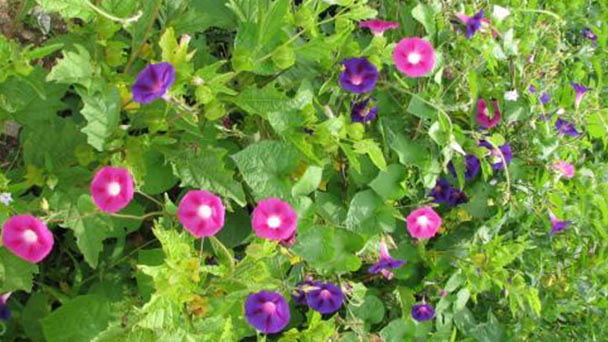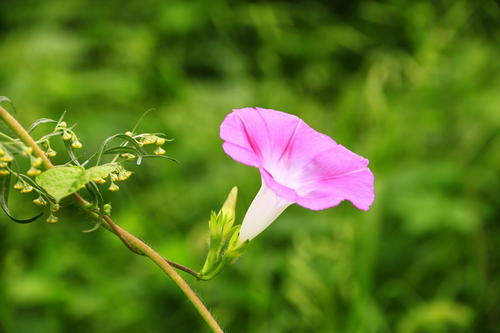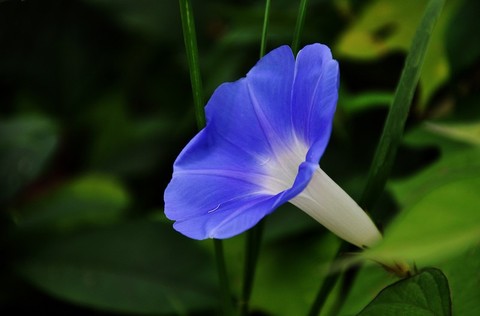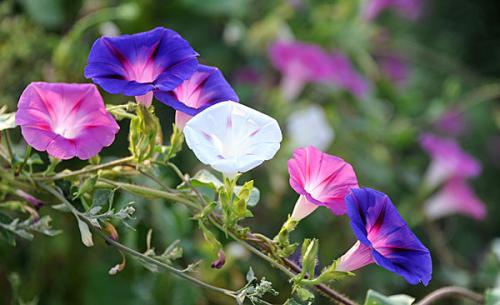Japanese morning glory (Ipomoea nil Roth) profile
Written by Maggie
Sep 01 2021

Japanese morning glory is an annual tendrils winding herb flowers. Japanese morning glory vining stems are slender, about 3 ~ 4 meters, the whole plant is densely short bristles. Leaves are alternate, entire or lobed. Cymes are axillary, 1 to several. Corolla is trumpet like. The designs are bright and beautiful. Capsule of Japanese morning glory is spherical, mature, dehiscent, large seed, black or yellow white, long life.
Japanese morning glory picture

Morphological characteristics of Japanese morning glory
Stems
Japanese morning glory is an annual twining herb with inverted pubescent stems mixed with inverted or spreading long bristles.
Leaf
Leaves of japanese morning glory are broadly ovate or suborbicular, deeply or shallowly 3-lobed, occasionally 5-lobed, 4 -- 15 cm long, 4.5 -- 14 cm wide, base rounded, cordiate, middle lobes oblong or ovoid, acuminate or acuminate, lateral lobes shorter, triangular, lobes acute or rounded, leaves sparsely or densely puberulent; Petiole of Japanese morning glory is 2-15 cm long, pilose with stem.
Flowers
Flowers of Japanese morning glory are axillary, simple or usually 2-borne at pedicel apex, pedicels of varying length, 1.5 -- 18.5 cm long, usually shorter than petiole, sometimes longer, trichomme identical; Bracts are linear or leaflike, spreading hirsute; Pedicels of Japanese morning glory are 2 -- 7 mm long; Bracteoles are linear; Sepals are subequal, 2-2.5 cm long, lanceolate linear, inner surface 2 slightly narrow, outside bristles spread, base more dense, sometimes pubescent; Corolla of Japanese morning glory is funnelform, 5-8 (-10) cm long, bluish purple or purplish red, corolla tubes pale; Stamens and styles are hidden; Stamens of Japanese morning glory are unequal in length; Filaments are basally pilose; Ovary is glabrous, stigmas capitate.
Fruit
Capsule of Japanese morning glory subglobose, 0.8-1.3 cm in diameter, 3-lobed. Seeds are ovate-triangular, ca. 6 mm long, dark brown or beige, covered with brown short tomentose.
Japanese morning glory is a strong and vigorous plant with mild climate, sufficient light and moderate ventilation. Japanese morning glory has strong adaptability to soil and is more resistant to drought and salt and alkali, and is not afraid of high temperature and heat. Japanese morning glory is a deep-rooted plant, and the soil should be deep.
Ecological habits of Japanese morning glory
Japanese morning glory grows in thickets on hillsides, along dry river valleys, near gardens and houses, along mountain roads, or cultivated at an altitude of 100-200 (-1600) meters.
Growing methods of Japanese morning glory
Germination warm: 20 ~ 25 ℃
Seeding time: Spring, summer,
Grow warm: 22 ~ 34 ℃
Flowering period: Summer, autumn
Seedling: soak seeds of Japanese morning glory in warm water for 4 ~ 6 hours or treat them with sulfuric acid. After sowing, cover the soil with about 1 cm, keep the soil warm and wet, and germinate after 5 ~ 6 days. Two leaves can be transplanted, and the plant spacing is 30 cm.
Choose the culture soil with good drainage and give Japanese morning glory full sunshine and a well-ventilated environment. Water should be irrigated when the surface of the soil in the basin is slightly dry during the growth period, and dilute liquid fertilizer should be applied once a half month. Nitrogenous fertilizer should not be too much to avoid excessive exuberant stems and leaves. Potted Japanese morning glory needs to be propped up.
Japanese Morning Glory is not only a good material for vertical greening of fence fences, but also suitable for potting and ornamental decoration of courtyard balconies. Potted Japanese morning glory should be installed in spring, with half common culture soil and plain sand soil, in two size pots (inner diameter of 13 cm), and 4 to 5 seeds in each pot. Because the seed coat of Japanese morning glory is thicker and germinates slowly, it can be carved with a knife in the upper part of the hilum. After sowing, keep 25℃ and germinate about 7 days. Observation of two cotyledon long flat seedling transplantation, can be the whole tuo basin to separate the seedlings with soil. When potted, the taproot will be removed at the lower end of 1 cm, planted in the second tube basin with ordinary culture soil, each pot is a plant, pay attention to the open transplantation of petunia, never touch the taproot, transplanting should be small, appropriate early, the bigger the soil lump the better.
When the seedlings of Japanese morning glory grow 6 ~ 7 leaves will be extended, the whole tuo out, put on the billet basin (inner diameter 24 cm) planting, pot soil to use fertilizer culture soil, and apply 50 grams of hoof as bottom fertilizer. Pour water thoroughly after planting. When the soil is in place, stick a 1-meter-long bamboo pole straight into the center of the basin. Then use about 3 meters long wire, one end of the soil surface wrapped in the bamboo pole, and then from the mouth of the basin circling upward, the formation of a large small symmetrical tower circling frame. The top end of the wire is fixed on the top of the bamboo pole. Japanese morning glory is a left-handed plant, and the spiral direction of the lead wire must conform to the habit of the morning glory winding to the left. When the main vine climbs to the top of the pole along the lead wire, pick the top. Side tendrils every long to 6 ~ 7 leaves when pinching, so that the flowers can be large, constantly blooming tendrils.
Planting method
Scientific planting of Japanese morning glory must be potted. This is not only convenient for scientific management, but also convenient for exhibition and evaluation, as well as to ensure the collection of fine varieties.
Potted Japanese morning glory can also make it not climb vine, develop dwarf clusters, rich plant type. When the seedlings grow 5 to 6 leaves, plant them in a second cylinder (inner diameter 23 cm). Then pinching tip to promote 2 ~ 3 side buds, the rest of the erasures. When the lateral bud develops leaves to extend tendrils, leave 2 ~ 3 leaves to point again. This can bloom about 10 at a time.After the flower withers immediately removed, promote its lateral branches to send new buds, drink to leave a few, redundant erase, still according to the law before pinching. This can keep the plant cluster always plump, flowers constantly.
Seedling
Japanese morning glory germination temperature is 20 ~ 30℃, generally in spring sowing (South can also advance), according to the variety of branch sowing in fine sandy soil seedbed, about 10 days when humidity is moderate germination.In about another 10 days, the cotyledons are completely open. When waiting for true leaf just germination, Japanese morning glory should be transplanted into a small basin, premature seedling is weak, too late injury root, go against the development after. The small pot should be well marked, indicating the variety.
Engraftment
Small pot seedlings grow two or three true leaves, this time the root system has developed well, you can be planted in the basin, and add good bottom fertilizer in advance. Japanese morning glory is not afraid of heavy fertilizer, and can use horseshoes, cooked hemp residue as base fertilizer. Japanese morning glory needs temperature to develop their roots, and according to Japanese researchers, black pots absorb heat better than red ones. We must often turn the basin to make the sunlight shine evenly, making the root system development complete.
Pick a heart
After three or four leaves of Japanese Morning Glory have grown, vines begin to grow in the center, which should be removed. After picking the heart for the first time, branches and tendrils between leaf axils, after waiting for branches and tendrils to give birth to three or four leaves, heart again, combined with plastic surgery at the same time. After each heart should be top dressing, the use of fertilizer and chrysanthemum with a similar top dressing. Be careful not to stain the leaves (including cotyledon) with fertilizer and mud, so as not to shed the leaves. When the branches and tendrils grow, they enter the flowering stage (usually one month after transplanting). Ideally, the first leaf of the branches and tendrils will produce axillary buds, and the second and third leaves will produce bud buds. After waiting for the bud to form, you can pick off the tuber of the bud, for the development of the bud. To ensure that the bracts are adequately supplied with nutrients to produce large, showy flowers, some of the bracts can also be removed and a single flower can be bred, just as a variety of Japanese morning glory is bred. After opening flowers to be removed, do not make them as seeds, so as not to affect the nutrition of the next batch of flowers. Of course, after three or four batches of flowers, the armpit buds are clumped, which is difficult to control. General varieties can be changed to plant, good varieties are ready to stay.
The plastic clip
Mainly ground planting and hedgerows decoration: pick the core when the main vines produce 7-8 leaves, leave 4 leaves, and leave 4 leaves for cutting when they have grown 3 branches. After Japanese morning glory growing 9 branches, evenly distributed in the fence or wall for binding, fording its growth, soon can form a hedge and flower wall.
When viewing in the salt plant room, a flower bracket can be set up in the pot when the seedling is about 6 cm high, so that it can be wound up. It can also leave 4 leaves when 7 ~ 8 leaves, and leave L leaves after growing 3 branches. Keep each Japanese morning glory to no more than 9 buds. This can make the plant shape plump flowers big. Basket cultivation can also be used.
Stallion
Good varieties must keep good seeds, to be ready to fall after the classification of labeling preservation. If there are variants, more should be retained. Japanese morning glory hybridization in the selection of female and male parents, in the evening the day before the flowering of the upper end of the bud cut off, then remove the stamens, with a wax paper bag wrapped. The next morning removed the wax paper bag, with the male parent's stamen for artificial pollination, and then with the wax paper bag wrapped, one or two weeks after the removal of the wax paper bag, but the pollination of the child package must be marked, good records. The next year all seeds that should hybridize the place are planted good, wait for the achievement after flowering, and can study the action of all sorts of genetic factors by it.
Japanese morning glory can be distinguished by the shape of the cotyledons so that they can be removed early. They can also estimate the color of the flower according to the young stem, such as white blue for white flowers, deep purple for purple flowers and so on. Cotyledons are shaped differently, true leaves are shaped differently, flowers are shaped differently.

Species classification of Japanese Morning Glory
There are about 60 kinds of morning glories. There are three types of common cultivation:
Lobed leaf petunia
Split leaves of petunia with deep trifid leaves, medium flowers 1 to 3 axillary, there are jade-blue, rose red or white.
Round leaf petunia
Round leaves, wide heart - shaped leaves, the whole margin, small flowers, white, red, jade-blue and other colors.
Big flower petunia
The current popular petunia with large flowers, leaves long stalk, with three lobes, large central lobes, easy to grow with irregular yellow and white patches. Flowers 1 to 3 axillary, peduncles shorter than petioles, large flowers to 10 cm or more in diameter, native to tropical Asia and Africa. This species is the most popular in Japan, called chaoyan flower, and breeding a number of horticultural varieties, flower type changes, colorful, widely popular.
Japanese morning glory distribution area
Japanese morning glory distributes in the Americas;
Disease control of Japanese morning glory
Symptoms
The main site of the disease is the leaf, petiole and tender stem of Japanese morning glory, the initial stage of the leaf has light green spots on the leaf. After becoming bright yellow, the edge is not obvious, serious when extended to large disease spot, late disease produce white scar a protrusion on the back, burst, send out a white powdery, sporocyst spores for germs, flowers, stems twisted, was caused when the tender bine suffer when the disease spot surrounded petioles, tender tip, cut above poor host part of the growth ring, atrophy of death.
Pathogen and regularity of disease
The pathogen was Albugoipomoeae panduranae, which belongs to a fungus of the genus Puccinia. In the following spring, the oospores bud to produce sporangia and invade convolvulae and other convolvulae plants. Generally, the peak period of the disease is in summer. The convolvulae can be planted in the pathogen and become the source of infection in the next year.
Method of prevention and cure
(1) Pulling out the diseased plant in time and destroying it. In order to reduce the seed impregnation.
(2) Selected and kept disease-free seeds as breeding seeds, seeds should be disinfected before sowing. Avoid crop rotation with convolvulous plants.
(3) Spraying L % Bordeaux liquid or 50% Phytophthora 500 times liquid at the early stage of disease, spraying once every 10 ~ 15 days has a better prevention and control effect.
Landscape use of Japanese morning glory
Japanese morning glory is a common vine flower in summer and autumn. Japanese morning glory can be used for shading of small courtyards and bedroom windows, beautification of small trellage and hedgerows, and can also be planted as ground cover.
Japanese morning glory flower language
Japanese morning glory flower language is reputation.

Latest Updated
- Benefits of Bugleweed - 7 Science-backed Health Benefits
- Bugleweed Dangers & Side Effects - Is It Poisonous?
- How to Plant Evergreen Trees - What You Should Know
- When to Plant Evergreens - Grow Guide for Evergreen Trees
- 12 Wonderful Evergreen Shrubs for Your Garden
- 12 Popular Evergreen Plants with Pictures for Beginners
- When And How To Prune A Lilac Bush Like a Pro
- How to Grow & Care for Lilac Vine (Hardenbergia Violacea)
- Japanese Lilac Tree (Syringa Reticulata) Care & Propagation Guide
- Shumard Oak Pros and Cons - What to Know
Popular Articles
- Winter maintenance of Antirrhinum Majus
- How to Grow Terminalia Mantaly Tree
- How to Grow and Care for Crossostephium Chinense
- How to grow Antirrhinum Majus in spring
- Peristeria Elata (Dove Orchid) Profile: Info & Care Guide
- Underwatered Snake Plant (Sansevieria Trifasciata) - Signs And How To Fix
- How to Care for Brazilian Jasmine Plant (Mandevilla Sanderi)
- How to Grow & Care for Graptopetalum Purple Delight in Summer
- Rosa Chinensis (China Rose): Plant Growing & Care Tips
- How to Care for Baby Sun Rose (Aptenia Cordifolia)